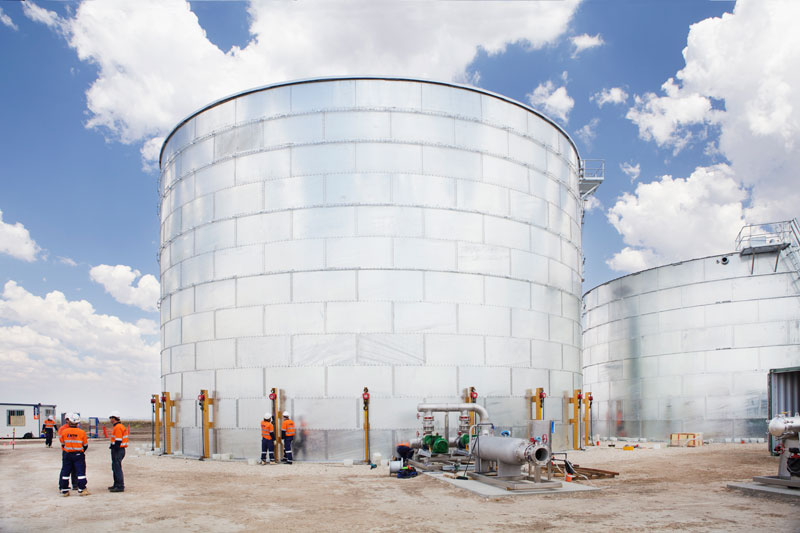
Tank Liners 101: A Primer on Tank Liners
What is a tank liner? Generally speaking, a tank liner is a material used inside storage tanks. The purpose of tank liners is to prevent the stored material from keeping contact with the tank’s metal or concrete structure.
Liners are made from different materials, and they are chosen according to the type of chemical stored inside the tank. Today, you will learn how tank liners work, what common materials are used to make them, and what kinds of tanks usually need tank liners.

Why Do We Need Tank Liners?
The main purpose of a tank liner is to protect your material. However, it does serve several other functions, which we will describe below.
Improves Impermeability – most tanks are made of metal and concrete. Overtime, water will find its way through these materials. Concrete absorbs moisture and has tiny holes that can accommodate water droplets. Metal can rust and water will seep through it. A tank liner is used to prevent leaks from happening.
Chemical Integrity – tank liners are used to maintain the chemical structure of liquids and other stored goods. In many cases, these liquids can get contaminated if they are exposed to metals and concrete. As such, a tank liner acts as a barrier between the tank and the stored material.
Weather Resistance – liners are made from materials that can absorb heat and protect the chemicals inside the tank. Most tanks are exposed under the sun, and this makes the tanks vulnerable to ultraviolet light and radiation.

Tank liners do a good job of keeping these elements away from direct contact to the substance inside the tank. Each tank liner is designed to perform these functions or all of them. Just imagine what would happen if your tank has a leak—you would be paying for water that is wasted without you realising it. Until it is too late.
In the Australian manufacturing industry, if the substance is exposed and contaminated, you can no longer use that for production, and that wasted material is a substantial loss for the company.
What materials are used for tank liners?
There are dozens of materials used to fabricate liners. Let us take a look at the common ones used in the industry.
Novolac Epoxy
This is a kind of epoxy used for onshore buried tanks. This is also used to line pipes and any structure where chemical passes through. Examples of these chemicals are crude oil and waste water. These pipes and tanks are buried other under the sea or underground. A liner like this can withstand temperatures of up to 160°C.
Vinyl Ester
Made from vinyl, this tank liner is highly resistant to chemical contamination. It is best used in chemical industries where the temperature is a key component of the manufacturing process. A vinyl ester tank is great for substances that need protection. Vinyl ester liners are highly resistant to temperature and chemical damage.
Phenolic Expoxy
This is a type of liner used for drilling mud tanks that are used in the oil industry. This can also withstand a temperature of to 160°C, and it is best suited for chemicals that are aggressive. It prevents contamination and maintains chemical integrity.
Polyurethane
A flexible tank liner used to line concrete tanks. Polyurethane is made of different molecules of rubber and plastic. These liners have steel-backed plates. The steel is bonded with them to allow them to have structural integrity. They are harder than rubber, but softer than plastic.
Cementitious Liners
A cementitious lining is made of a material that is combination of epoxy and polymers. This is a lining that is commonly used in concrete tanks because they bond well with concrete. A liner like this is used mainly in water treatment facilities and residential water tanks that are made of concrete. They serve well in making the tank waterproof to prevent leakage.
Zinc Liners
A zinc tank liner is anti-corrosive. If a liquid comes in contact with metal, the metal corrodes because of the liquid’s chemical content particularly oxygen in water. Zinc acts as a barrier between the metal tank and the chemical. Zinc is also effective in fighting leakage. It is a waterproof material if used with other binders. Zinc liners are easy to clean and maintain, and they are great at filling up pores and holes in the metal substrate of the tank. Zinc, however, is not resistant to acid so it has limited use.

What should you know before buying a liner?
Here are few tips to help you choose your liners carefully.
Installation – choose tank liners that are easy to install. Today, there are liners that come in the form of rubber paint. This is the preferred choice of many because it has to be painted, and then it can work its magic once it is dry.
Customisation – tank liners must be customisable. It is important that the liner is fabricated to the exact specification of your tank. If the material and the liner cannot be customised, your liquid or stored material is eventually going to leak or have a chemical reaction against the tank.
Regulated –the material used in the liner must be regulated and compliant with industry standards. After all, what you are storing in your tank is likely to be water or food. The same applies with petroleum tanks. Petrol is a highly flammable material, and you need a tank liner that can prevent the liquid from catching fire.

Summary
Liners are made of various materials, and they have to be carefully chosen by experts in relation to the substance that is going to be stored. There is no one-size-fits all type of liner, as different liquids react to metal and concrete in different ways. If you are in the process of having a liner installed, customised, or fabricated, spend some time with experts and talk to them about your needs.
Residential water tanks require simple materials, but chemicals, water waste and petroleum all need tank liners that can withstand pressure and high temperature. Tank liners are mandatory requirements for all tanks. Skipping this means you are putting yourself and your tank at risk.
- How to Fix Leaks in Your Water Storage Tanks - December 14, 2025
- Effective Techniques for Thorough Tank Cleaning - December 14, 2025
- The Benefits of ROV Tank Inspections for Maintenance - December 14, 2025






